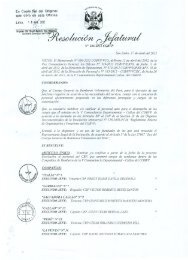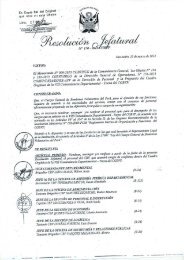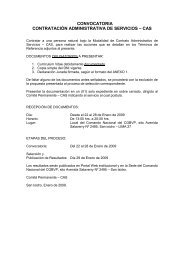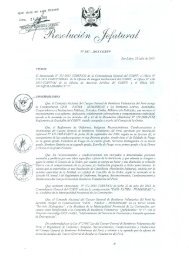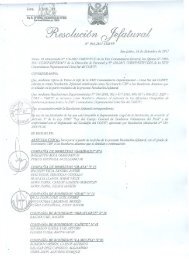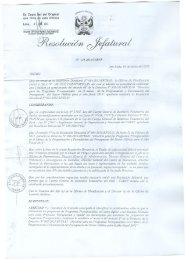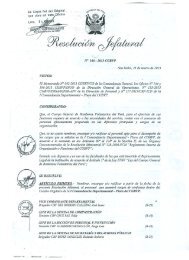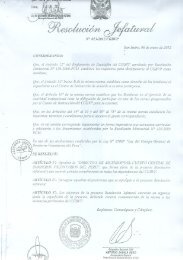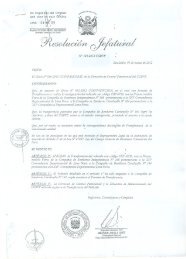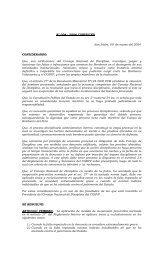Revista PDF - Cuerpo General de Bomberos Voluntarios del Perú
Revista PDF - Cuerpo General de Bomberos Voluntarios del Perú
Revista PDF - Cuerpo General de Bomberos Voluntarios del Perú
- No tags were found...
You also want an ePaper? Increase the reach of your titles
YUMPU automatically turns print PDFs into web optimized ePapers that Google loves.
CORAL TECHNICAL REQUIREMENTS DRAFT August XX, 20135.0 CORAL Compute PartitionThis section <strong>de</strong>scribes additional hardware and software requirements for the CORAL compute partition<strong>de</strong>scribed by the Offer as part of Section 3.1.5.1 Compute Partition Hardware Requirements5.1.1 IEEE 754 32-Bit and 64-Bit Floating Point Numbers (TR-1)The CORAL compute no<strong>de</strong> (CN) processor cores will have the ability to operate on 32-bit and64-bit IEEE 754 floating-point numbers5.1.2 Inter Core Communication (TR-1)CN cores will provi<strong>de</strong> sufficient atomic capabilities along with some atomic incrementingcapabilities so that the usual higher level synchronizations (e.g., critical section or barrier) can beconstructed. These capabilities will allow the construction of memory and executionsynchronization that is extremely low latency. As the number of user threads can be large in aCORAL no<strong>de</strong>, special hardware mechanisms will be provi<strong>de</strong>d that allow groups of threads tocoordinate collectively at a cost comparable to the cost of a memory access. Multiple groupsshould be able to synchronize concurrently. Hardware support will be provi<strong>de</strong>d to allow forDMA to be coherent with the local no<strong>de</strong> memory. These synchronization capabilities or theirhigher-level equivalents will be directly accessible from user programs.Offer will specify the overhead, assuming no contention, of all supplied atomic instructions.5.1.3 Hardware Support for Low Overhead Threads (TR-1)The CNs will provi<strong>de</strong> documented hardware mechanisms to spawn, to control and to terminatelow overhead computational threads, including a low overhead locking mechanism and a highlyefficient fetch and increment operation for memory consistency among the threads. Offeror willfully <strong>de</strong>scribe these mechanisms; their limitations and the potential benefit to CORALapplications for exploiting OpenMP and POSIX threads no<strong>de</strong> parallelism within MPI processes.5.1.4 Hardware Interrupt (TR-2)CNs hardware will support interrupting given subsets of cores based on conditions <strong>de</strong>tected bythe operating system or other cores within the subset executing the same user application.5.1.5 Hardware Performance Monitors (TR-1)The CNs will have hardware support for monitoring system performance. The hardwareperformance monitor (HPM) interface will be capable of separately counting hardware eventsgenerated by every thread executing on every core in the no<strong>de</strong>. The HPM will inclu<strong>de</strong> hardwaresupport for monitoring message passing performance and congestion on all no<strong>de</strong> interconnectinterfaces of all proposed networks.The HPM will have 64b counters and the ability to notify the no<strong>de</strong> OS of counter wrapping. TheHPM will support setting of counter values, saving them and restoring them, as well as readingthem in or<strong>de</strong>r to support sampling based on counter wrapping. The HPM will also supportinstruction-based sampling (e.g., PEBS or IBS) that tracks latencies or other data of interest inrelation to specific instructions. All HPM data will be ma<strong>de</strong> available directly to applicationsprogrammers and to co<strong>de</strong> <strong>de</strong>velopment tools (see section 9.2.2.9).- 22 -



